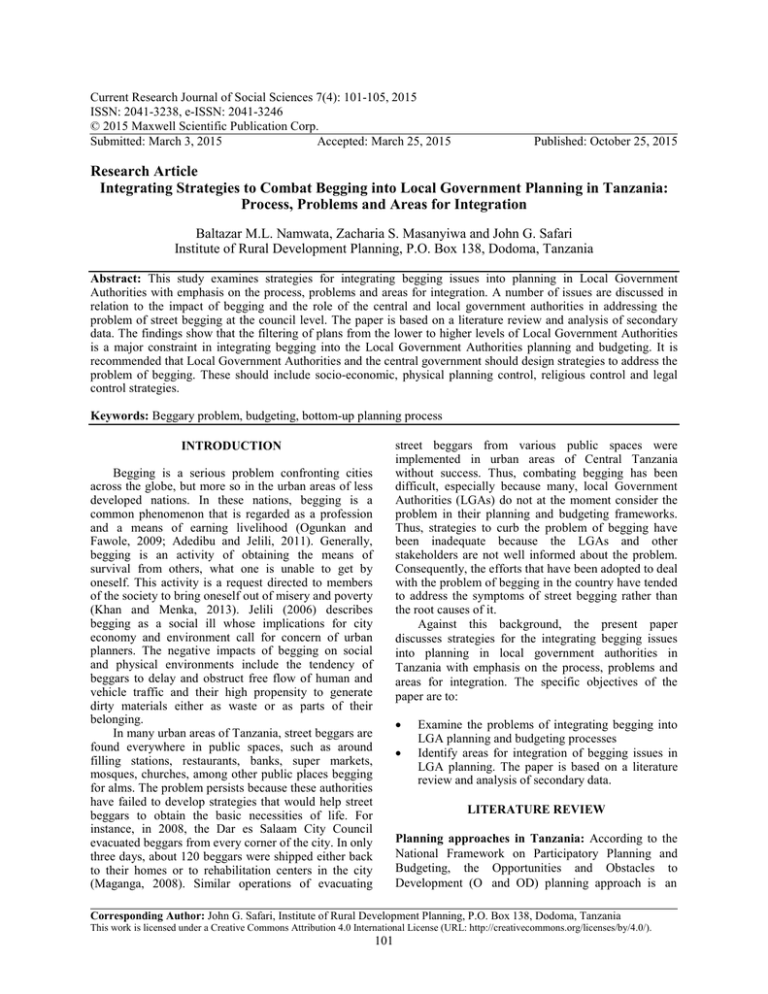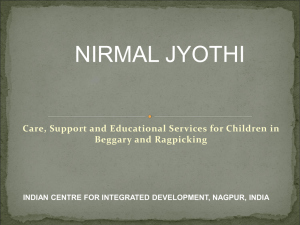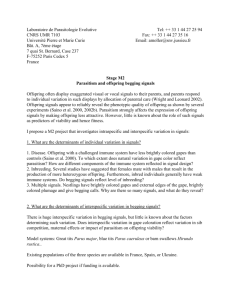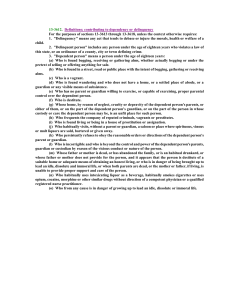Current Research Journal of Social Sciences 7(4): 101-105, 2015
advertisement

Current Research Journal of Social Sciences 7(4): 101-105, 2015 ISSN: 2041-3238, e-ISSN: 2041-3246 © 2015 Maxwell Scientific Publication Corp. Submitted: March 3, 2015 Accepted: March 25, 2015 Published: October 25, 2015 Research Article Integrating Strategies to Combat Begging into Local Government Planning in Tanzania: Process, Problems and Areas for Integration Baltazar M.L. Namwata, Zacharia S. Masanyiwa and John G. Safari Institute of Rural Development Planning, P.O. Box 138, Dodoma, Tanzania Abstract: This study examines strategies for integrating begging issues into planning in Local Government Authorities with emphasis on the process, problems and areas for integration. A number of issues are discussed in relation to the impact of begging and the role of the central and local government authorities in addressing the problem of street begging at the council level. The paper is based on a literature review and analysis of secondary data. The findings show that the filtering of plans from the lower to higher levels of Local Government Authorities is a major constraint in integrating begging into the Local Government Authorities planning and budgeting. It is recommended that Local Government Authorities and the central government should design strategies to address the problem of begging. These should include socio-economic, physical planning control, religious control and legal control strategies. Keywords: Beggary problem, budgeting, bottom-up planning process street beggars from various public spaces were implemented in urban areas of Central Tanzania without success. Thus, combating begging has been difficult, especially because many, local Government Authorities (LGAs) do not at the moment consider the problem in their planning and budgeting frameworks. Thus, strategies to curb the problem of begging have been inadequate because the LGAs and other stakeholders are not well informed about the problem. Consequently, the efforts that have been adopted to deal with the problem of begging in the country have tended to address the symptoms of street begging rather than the root causes of it. Against this background, the present paper discusses strategies for the integrating begging issues into planning in local government authorities in Tanzania with emphasis on the process, problems and areas for integration. The specific objectives of the paper are to: INTRODUCTION Begging is a serious problem confronting cities across the globe, but more so in the urban areas of less developed nations. In these nations, begging is a common phenomenon that is regarded as a profession and a means of earning livelihood (Ogunkan and Fawole, 2009; Adedibu and Jelili, 2011). Generally, begging is an activity of obtaining the means of survival from others, what one is unable to get by oneself. This activity is a request directed to members of the society to bring oneself out of misery and poverty (Khan and Menka, 2013). Jelili (2006) describes begging as a social ill whose implications for city economy and environment call for concern of urban planners. The negative impacts of begging on social and physical environments include the tendency of beggars to delay and obstruct free flow of human and vehicle traffic and their high propensity to generate dirty materials either as waste or as parts of their belonging. In many urban areas of Tanzania, street beggars are found everywhere in public spaces, such as around filling stations, restaurants, banks, super markets, mosques, churches, among other public places begging for alms. The problem persists because these authorities have failed to develop strategies that would help street beggars to obtain the basic necessities of life. For instance, in 2008, the Dar es Salaam City Council evacuated beggars from every corner of the city. In only three days, about 120 beggars were shipped either back to their homes or to rehabilitation centers in the city (Maganga, 2008). Similar operations of evacuating • • Examine the problems of integrating begging into LGA planning and budgeting processes Identify areas for integration of begging issues in LGA planning. The paper is based on a literature review and analysis of secondary data. LITERATURE REVIEW Planning approaches in Tanzania: According to the National Framework on Participatory Planning and Budgeting, the Opportunities and Obstacles to Development (O and OD) planning approach is an Corresponding Author: John G. Safari, Institute of Rural Development Planning, P.O. Box 138, Dodoma, Tanzania This work is licensed under a Creative Commons Attribution 4.0 International License (URL: http://creativecommons.org/licenses/by/4.0/). 101 Curr. Res. J. Soc. Sci., 7(4): 101-105, 2015 Fig. 1: Planning Approaches in Tanzania as adopted from PMO-RALG (2007a); RPFB = Rolling Plan and Forward Budget; MTEF = Medium-Term Expenditure Framework; LGA = Local Government Authority instrument for facilitating ‘bottom-up’ participatory development. The O and OD methodology provides guiding principles for participatory planning and budgeting in LGAs by describing the legal framework, roles and responsibilities of government institutions at different governance levels (including district, ward and village/mtaa1 levels) (PMO-RALG, 2007a, b). Because the former ‘top-down’ planning system did not provide room for effective community participation at the village and mtaa levels, O and OD aims to fill this gap by harmonizing different participatory approaches used in different sectors (Fig. 1). This approach has been designed to guide communities in identifying available resources to overcome obstacles and to foster the spirit of self-reliance, enlighten community members of their own resources and how best to use them for selfreliance, employ participatory tools and facilitate identification of sources of income and expenditure. It also enables the community to identify logical frameworks and priorities that lead to a comprehensive plan rather than an action plan and allows for interaction between bureaucrats and communities as well as between the different governmental levels (PMO-RALG, 2007a, b; Fjeldstad et al., 2010). and LGAs are required to provide the necessary inputs for future PBGs in order to improve integration of staffing levels with financial resource allocations in the medium term (URT, 2008). Generally, the PBGs provide information to councils (through PMO-RALG) about levels of funding by way of grants for the subsequent year and a timetable to submit estimates of revenue and expenditure. The levels of funding in the PBGs are used in determining indicative planning figures for use by kitongoji, villages and urban mitaa in preparing their plans. The PMO-RALG gives guidance to both councils and regional authorities on the PBGs After receiving planning guidelines Local Government authorities communicate them to the wards Planning and budgeting in Tanzania starts at grassroots (URT, 2006). In this process, villages and mitaa, as corporate bodies within LGA’s structure, prepare their strategic plans at that level, with the requirement that planning should be bottom-up and participatory, ensuring that people’s priorities are captured in the council annual plans and budgets. The ward and district levels consolidate the plans for submission to the Regional secretariat which scrutinizes and prepares Regional plan and budget (URT, 2009). At the national level, all LGAs’ plans are integrated to form a national plan. Preparation of National plan and budget is then mediated by PMO-RALG. However, many problems of communities including beggary problem are normally ignored at high levels of planning and budgeting process in local government authorities. Experiences show that in normal practice there is no guideline to integrate begging issues in the planning and budgeting process of the LGAs. Upon receiving the proposals from communities, the council’s planning office is responsible for producing a draft consolidated community plan, as well as the tentative recurrent and development budget proposals. These are then discussed by the heads of sector departments within the council to ensure that proposals are technically feasible and in accordance with sector plans before they are Planning and budgeting process in local government authorities: As a procedure, the annual planning and budgeting process begins with issuance of national Planning and Budget Guidelines (PBG). The PBGs contain a summary of the macro economic performance in the previous year, policy commitments, priorities and strategies, policies on credit system and general liquidity, inflation and employment levels; forecasted resources envelope and framework on recurrent and development budget. The summary also entails expenditure ceilings to guide Ministries, Departments and Agencies (MDAs) and Regions and LGAs. The guidelines are prepared by the Treasury together with Prime Minister’s Office Regional Administration and Local Government (PMO-RALG). Accordingly, MDAs 102 Curr. Res. J. Soc. Sci., 7(4): 101-105, 2015 integrated into the overall council plan. In theory, further consultations with communities are expected to take place when reviewing and revising the plans. In practice, however, this step marks the end of the ‘participatory planning processes’. on the understanding that communities have different needs and resources. This implies that priorities will differ by community unless interventions are imposed from outside. Evidence, however, presents a different picture. Generally, communities have tended to produce the same list of priorities, which also happen to coincide with central government priorities. This ‘coincidence’ in prioritization happens because, given limited resources, communities are ‘forced’ to drop locally preferred proposals in favour of central government priorities. Therefore, the issue is not which issues should be accorded higher priority than others, but finding the right balance between local needs and national priorities (Masanyiwa, 2014). O and OD in practice: Experience from LGAs in Tanzania: According to Fjeldstad et al. (2010), implementation of O and OD planning methodology in Tanzania is hindered by a number of interrelated problems: delays in receiving guidelines and budget ceilings; needs and activities in local plans not effectively rationalized and/or prioritised by communities and have rather tended to be ‘lists of wishes’; central government priorities determine community decisions. In the actual fact, the process of implementing O and OD methodology is characterized by limited interaction between council staff and communities. Nevertheless, regional and central government bureaucrats ultimately hold decisionmaking power over local plans. Thus, as others have noted the existing participatory planning process is still limited in scope and disconnected from LGA planning and funding mechanisms (Cooksey and Kikula, 2005; Masanyiwa, 2014). This is one area that reflects decentralization of administrative functions without devolving the power. Decisive role of the bureaucrats: As described above, community plans are submitted to the council management team for screening and prioritization. In theory, the plans are based on community priorities, but in practice they accord with the central government directives. Screening also assesses the budget implications of the plans. Most project proposals which are not in accordance with the national priorities will automatically end up scoring low on the council priority list. Compiled plan and budget proposals are then submitted to the various standing committees of the council for further review and political input. Experience has shown that discussions in the council committees mainly focus on the locations of projects since such decisions are critical for the re-election of existing councilors. Thereafter, the proposals are submitted to the council’s finance committee for approval. The finance committee is made up of heads of the various standing committees and other elected councilors. Before endorsement of the plan and budget by the full council, the draft plan and budget must be submitted to the Regional Administrative Secretariat (RAS) for consultation whether the plan is in accordance with national priorities and policies. Finally, the Ministry of Finance (MoF) may suggest amendments to the approved plan and budget, usually in consultation with the council’s executives without consulting councilors (Cooksey and Kikula, 2005; Fjeldstad et al., 2010). A list of wishes: In theory, bottom-up planning begins with preparation of community plans, namely, Village Development Plans (VDPs) in rural LGAs and Ward Development Plans (WDPs) in urban LGAs, based on priorities identified by communities. To ensure that the views of all social groups are reflected in the plan, community members are expected to be organized into groups based on gender, age and social status. In addition, primary data to inform the plan must be collected by community members themselves using participatory tools. The draft plan is then presented to the village or mtaa council for prioritization and budgeting before presentation to the Ward Development Committee for technical advice and final submission to the village assembly for approval as stipulated by the law. The practice, however, may be different. Most plans are submitted by villages or mitaa as ‘lists of wishes’ without going through these processes (Cooksey and Kikula, 2005; Fjeldstad et al., 2010). This is supported by a study on community involvement in planning process in Dodoma Municipality by Norman and Massoi (2010) which concluded that although, Decentralization by Devolution calls for community involvement in deciding matters affecting their livelihoods including planning and setting their priorities Mitaa residents are not involved in the planning process; rather they are involved in the implementation of the centrally made plans that did not include their priorities. RESULTS AND DISCUSSION Problems of integrating begging into LGA planning and budgeting: Based on the discussion in the previous section, the filtering of plans from lower levels of LGA (the mtaa and village levels) seem to be a major constraint in integrating strategies to combat begging issues in LGA plans and budgets. As a result, there are no plans and budgets to support strategies for combating street begging. In a study by Namwata et al. (2014) in Dodoma and Singida, it was found that LGA planners had been preparing plans and budgets without taking into account the needs of beggars. Similarly, planning meetings using the O and OD methodology Central government priorities determine community decisions: The concept of O and OD planning is based 103 Curr. Res. J. Soc. Sci., 7(4): 101-105, 2015 Table 1: Integrating begging into local development planning Areas for integration Local development planning interventions Socio-economic Support poverty reduction programmes that would have direct bearing on beggars and different categories of the interventions needy people. Establishment of sustainable and effective rehabilitation schemes. In each of the LGA, there is need for establishment of vocational rehabilitation centre to address the problem of street beggars and prevent them from becoming beggars, or stop them from remaining beggars. Each centre should provide services such as guidance and counseling, vocation training, health and social welfare, Physical planning In each of the urban areas regular surveys of beggar’s stations should be carried out. With these surveys, less hidecontrol interventions out and convenient spots will be available for beggars to carry on their business. Development control activities in urban areas should, through proper monitoring team, include evacuation of street beggars from public spaces which provide good avenues for begging activities. Various actors and places including mosques, churches motor parks, filling stations and markets, among others, should discourage begging activities. Religious control People’s perception about the begging phenomenon should change. Religious groups have an important role to play interventions in this regard, as giving alms to the needy does not give the needy the license to remain and feel comfortable with begging. Instead, religious groups should design mechanism to support those who genuinely deserve such help. There should be regular campaigns and/or public enlightenment programmes on the dehumanizing implication of begging for the beggar and their relations. There should be a detailed urban development policy and procedures for its enforcement that has specific provisions Legal control interventions on issues of begging. Beggars should not be allowed to stay or roam in the street of urban areas. Adapted and modified from Adedibu and Jelili (2011) were not regularly conducted so as to provide space for the inclusion of begging issues into LGA plans and budgets. By the time the planners are consolidating LGA plans from the village and mitaa levels, strategies for combating begging were not considered in budget allocation. In another study that investigated street begging life in central Tanzania, lack of funding was identified by the municipal officials as the single most limiting factor in controlling street begging in the area (Namwata et al., 2014). according to their own priorities. In turn, the filtering of plans from lower levels of LGA (the village and mtaa levels) is a major constraint in integrating begging issues into LGA plans and budgets. As such, there are no plans and budgets to support strategies for combating street begging. Yet begging may not be reduced or eliminated unless stern measures are taken to break the cycle. Considering the complex nature of begging, there is a need for LGAs and the central government to provide effective strategies for integrating begging into LGA planning and budgeting to tackle the root causes of begging including socioeconomic strategies, physical planning control strategies, religious control strategies and legal control strategies. Areas for integration of begging issues into local government planning: Adedibu and Jelili (2011) are of the view that begging is not a problem specific to certain countries. It is an urban problem noticeable in every urban centre of every country. However, the problem of begging is significantly higher in some parts of the country than others. The more urban a town or city is, the more it attracts or generates beggars. The planning implication of this is that as more urban areas spring up while the existing ones grow bigger, there is a need for adequate urban development management techniques capable of instituting checks against negative implications of increasing urban growth, including begging. This calls for the need for urban planners to consider integrating street begging into urban planning and budgeting. Drawing on the framework proposed by Adedibu and Jelili (2011), we argue that in collaboration with other actors in the LGAs, strategies to combat begging can be integrated into LGAs’ budgets and plans in four intervention areas. These are socio-economic, physical planning control, religious control and legal control interventions (Table 1). REFERENCES Adedibu, A.A. and M.O. Jelili, 2011. Package for controlling street begging and rehabilitating beggars and the physically challenged in Nigeria: Paper for policy consideration. Global J. Hum. Soc. Sci., 11(1). Cooksey, B. and I. Kikula, 2005. When bottom-up meets top-down: The limits of local participation in local government planning in Tanzania. Special Paper 17, Research on Poverty Alleviation (REPOA), Mkuki na Nyota Publishers, Dar es Salaam. Fjeldstad, O., L. Katera and E. Ngalewa, 2010. Planning in local government authorities in Tanzania: Bottom-up meets top-down. Brief No. 18, Research on Poverty Alleviation (REPOA), Dar es Salaam. Jelili, M.O., 2006. Environmental and socio-economic dimensions of Begging in Ilorin and Ogbomoso. M.Tech. Thesis, Department of Urban Regional Planning, Ladoke Akintola University of Technology, Ogbomoso, Nigeria. CONCLUSION It has been revealed in this study that limited implementation of O and OD has consequently resulted in reduced powers of communities to plan and budget 104 Curr. Res. J. Soc. Sci., 7(4): 101-105, 2015 Khan, J.H. and Menka, 2013. Quality of life of urban Beggars in Aligarh District. Int. J. Soc. Sci., 15: 70-80. Maganga, H., 2008. Ombaomba Dar Es Salaam waendelea kukaidi agizo la Kandoro. Retrieved from: http://www.newhabari.com/mtanzania habari.php. (Accessed on: April 16, 2010). Masanyiwa, Z.S., 2014. Decision making under the tree: Gender perspectives on decentralization reforms in service delivery in rural Tanzania. Ph.D. Thesis, Wageningen University, Wageningen. Namwata, B.M.L., M.R. Mgabo and P.J. Dimoso, 2014. Street begging and begging life in urban areas of central Tanzania. Final Research Report Submitted to Research on Poverty Alleviation (REPOA), Dar Es Salaam, Tanzania. Norman, A.S. and L. Massoi, 2010. Decentralization by devolution: Reflections on community involvement in planning process in Tanzania. Educ. Res. Rev., 5(6): 314-322. Ogunkan, D.V. and O.A. Fawole, 2009. Incidence and socio-economic dimensions of begging in Nigerian cities: The case of Ogbomoso. Int. NGO J., 4(12): 498-503. PMO-RALG, 2007a. Historical perspective on participatory planning in Tanzania. Retrieved from: http: //www.pmoralg.go.tz/lgrp/otherdocu.php. (Accessed on: August 2014). PMO-RALG, 2007b. Opportunities and Obstacles to Development: A Community Participatory Planning Methodology. Prime Minister’s Office Regional Administration and Local Government, The United Republic of Tanzania. URT, 2006. Embedding decentralization by devolution across government, strategy and roadmap. Final Draft, Government Printers, Dar es Salaam. URT, 2008. Guidelines for mainstreaming environment into sectors and local government authorities’ plans and budgets. Vice President’s Office, Dar es Salaam. URT, 2009. Guidelines for the Preparation of Medium Term Plan and Budget Framework for 2009/102011/12. Retrieved from: www.policyforum-tz.org ›PF-related. Endnote: 1 The mtaa (plural mitaa) is the lowest unit of government in urban areas in Tanzania. Each urban ward is divided into mitaa or neighbourhoods consisting of a number of households, which the urban council may determine. 105





